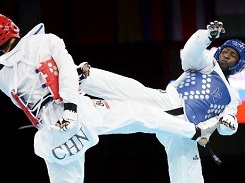I have been active in sports and martial arts for years (ever since I was in college). I have done full contact tae kwon do, sparred many, many rounds, and fought in the ring. However, I think the biggest accomplishment remains earning my blackbelt under The Pit, Sifu Garcia and within John Hackleman’s system of schools. It’s a difficult belt to earn as it requires a combination of kickboxing, hawaiian tempo, sanshou, and crosspit (crossfit with a vengeance). Recently we added Kore jiujitsu as well under the great Luigi Mondelli. It’s like a who’s who list of coaches and yet they make it incredibly personal and find ways to focus more on making you the best version of you that you can be. So here are ten things that having a blackbelt means to me:
- It represents several years and hours of practice chasing a goal and eventually attaining it. I think too many times people give up on their goals because they are difficult. No kidding! Very few things in life that are worth achieving come easily at least for most of us.
- Going through this journey of learning various techniques has given me the confidence to know that if I find myself in a life threatening situation in the streets, I have a fighting chance at survival. Hopefully that never happens, but if it does I know that I am not going down without a fight.
- I have learned to respect and listen to my body better than in any other sport I have ever played/practiced. I have blown out two calves, torn my bicep, broken my nose, and other various injuries. Through all of that though I learned what my body can and cannot take. That is useful information.
- I have gained a tight-knit circle of friends that also participate at the pit that I would have never met had it not been for our training. Why is that key? Because surrounding yourself with good, positive people is important in life. Very few successful people get there alone and our team is always there for each other offering encouragement for every practice, round of sparring, or fight. We call it our pit ohana (family).
- Through training at the pit and earning my blackbelt I have attained a higher level of physical conditioning than I ever did by just going to the gym doing cardio and lifting weights. I am not sure why but I can tell you that several rounds of sparring or rolling in jiu jitsu will fully exhaust every muscle in my body.
- In my house, training in kickboxing is a family activity. My son is 11 and he also has a blackbelt from the pit. Having something that the family can do together is important especially when it is something that builds confidence and serves to keep the whole family safer.
- Having a blackbelt really just marks another stop on the journey toward becoming the best that I can be. I’ll continue pursuing degrees and building upon this solid foundation. So earning a blackbelt for me is not a final destination at all, it simply marks a significant point on my map of life.
- It’s hard to have a list of what a blackbelt means without acknowledging the support of others that helped me accomplish this goal. My wife, family, friends, and work all showed exceptional support without which I could not have made it. Thank you all for the inspiration and patience as I trained and nursed several injuries from fighting!
- Having a blackbelt also means that I have a deeper understanding of what it takes for others to fight and to attain various levels of success. Watching a muay thai, kickboxing, or MMA fight is completely different after you have fought in fights yourself. The level of appreciation for both fighters is much higher.
- Finally, I want to say that earning a blackbelt also means that I had amazing guidance from the teachers and staff at the pit. The techniques that they teach are not easy to master but I’m sure they are also not easy to teach. Thanks to all of them as well for pointing out my flaws and helping me improve every day!
So I’m not sure if others will feel the same way about the belts they have earned. I know many fighters that don’t care about belt rank at all (some fighting styles don’t even have a ranking system). I have a healthy respect for every martial art and for every martial artist. Honestly, even if you never step into a ring or octagon it’s important to celebrate your achievements. Becoming a better version of yourself is a matter of setting goals and putting in the time and effort to attain them. For me, having a blackbelt represents all of these things and much more. Now, it’s time to get back to work, hit some pads, do some sparring, and keep growing!
 The world can be a dangerous place, there’s no doubt about it. Some things, however, aren’t quite as dangerous as you may believe. Despite the hype of sensationalist media outlets, these 20 activities are, from a statistical standpoint, not nearly as treacherous as many believe them to be.
The world can be a dangerous place, there’s no doubt about it. Some things, however, aren’t quite as dangerous as you may believe. Despite the hype of sensationalist media outlets, these 20 activities are, from a statistical standpoint, not nearly as treacherous as many believe them to be. When you have a talent for the unusual, the world doesn’t often welcome you with open arms. There are times, however, when the brightest stars rise to the top and everyone takes notice. These talented individuals lead the way for others to express their gifts, and often make lasting contributions to society as a whole. When it comes to excelling at unusual things, these 10 Kens have the market cornered.
When you have a talent for the unusual, the world doesn’t often welcome you with open arms. There are times, however, when the brightest stars rise to the top and everyone takes notice. These talented individuals lead the way for others to express their gifts, and often make lasting contributions to society as a whole. When it comes to excelling at unusual things, these 10 Kens have the market cornered. Participation in group sports has a wide range of benefits for kids, from teaching them valuable teamwork skills to encouraging physical fitness and active play. However, organized sports can also bring out the worst in kids if they’re not taught the importance of good sportsmanship and why they should always work to be good sports. Fostering a sense of good sportsmanship starts at home, and isn’t the sole responsibility of coaches. These tips can help you create an environment in which sportsmanship reigns supreme and avoid potential problems with kids’ behavior later.
Participation in group sports has a wide range of benefits for kids, from teaching them valuable teamwork skills to encouraging physical fitness and active play. However, organized sports can also bring out the worst in kids if they’re not taught the importance of good sportsmanship and why they should always work to be good sports. Fostering a sense of good sportsmanship starts at home, and isn’t the sole responsibility of coaches. These tips can help you create an environment in which sportsmanship reigns supreme and avoid potential problems with kids’ behavior later. In Japanese, the name “Ken” means “healthy and strong.” With a meaning like that, it’s no wonder that so many popular and successful martial artists have shared this very appropriate moniker. These are 10 of the most celebrated Kens in martial arts, each of which has their own unique claim to fame in the world of fighting.
In Japanese, the name “Ken” means “healthy and strong.” With a meaning like that, it’s no wonder that so many popular and successful martial artists have shared this very appropriate moniker. These are 10 of the most celebrated Kens in martial arts, each of which has their own unique claim to fame in the world of fighting. More and more people are jumping on the tattoo bandwagon it seems. Several of my friends have recently gotten their first ink and they are all in their 40’s. However, while tattoos may be increasingly common, talented tattoo artists certainly aren’t a dime a dozen. These ten have more in common than just their names; they’re also well respected tattooists who’ve made their mark on many a human canvas.
More and more people are jumping on the tattoo bandwagon it seems. Several of my friends have recently gotten their first ink and they are all in their 40’s. However, while tattoos may be increasingly common, talented tattoo artists certainly aren’t a dime a dozen. These ten have more in common than just their names; they’re also well respected tattooists who’ve made their mark on many a human canvas.